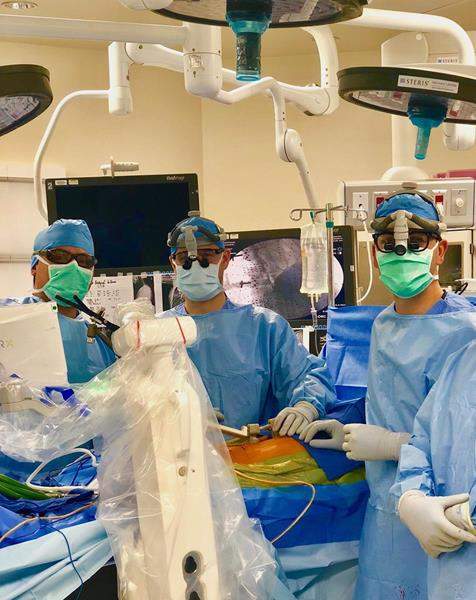Surgeons at Virginia Spine Institute have performed a new surgery using robotic guidance system, dubbed Mazor X Stealth Edition.

Image: Surgeons performing the robotic surgery at Virginia Spine Institute. Photo: Courtesy of GlobeNewswire.
Virginia Spine Institute claims that the device, co-developed by Medtronic and Israel-based Mazor Robotics, can be good news for millions of patients suffering from back problems, including scoliosis and other spine conditions; it also means increased safety for surgeons.
Spine surgeons at the institute Christopher Good and Colin Haines used the robotic guidance system to perform complex scoliosis correction surgery.
The Mazor X Stealth combines the precision of robotics with accurate intra-operative navigation, that gives surgeons control and patients can experience improved outcomes.
Last November, the system received approval from the US Food and Drug Administration (FDA) and is expected to be launched in key regions later this year.
The system has intra-operative robotic-guidance combined with simultaneous navigation technology to make spinal surgeries more accurate, thereby reducing the risk of patient complications and the possibility of revision surgeries.
Christopher Good, had recently presented a study which showed that minimally invasive robotic guided spine surgery can decrease the use of radiation in the operating room by 76%, benefiting both the patient and the surgical team.
Christopher Good said: “The marriage of robotics and navigation represents the future of computerized planning and execution in spine surgery and I am proud that the Virginia Spine Institute has been involved in this major breakthrough. Robotics and navigation have both been shown to improve accuracy and precision in spine surgery.
“The Mazor X Stealth Edition is a revolutionary new technology that uses state-of-the-art software to plan the ideal surgical procedure, then uses a robotic arm to guide to the steps of the surgical procedure with extreme accuracy while simultaneously using real-time imaging feedback to ensure the plan is being carried out as desired, ultimately leading to better outcomes for our patients.”
